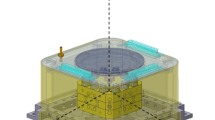Abstract
The Bremen drop tower at the Center of Applied Space Technology and Microgravity (ZARM) provides high quality micro-g condition needed for many high precision tests. This is even more improved by the development of a free flyer technology. This new technology is used for a free fall test of the MICROSCOPE differential accelerometers which only can work with a residual acceleration disturbance level below 25 nano-g in the high resolution mode. The French MICROSCOPE space mission for testing the Weak Equivalence Principle is scheduled for 2012/2013. The free fall accelerometer test campaign at ZARM is an important part of the pre-mission test program. In this article the new free flyer technology, its performance as well as the accelerometer tests are described.
Similar content being viewed by others
References
Bremer, S., List, M.: Modelling of the MICROSCOPE mission. In: Proceedings “Satellite dynamics: Modelling, In Orbit Callibration and Data Processing”. Space Sci. Rev. 151, 39–48 (2010). doi:10.1007/s11214-009-9599-1
Damour, T.: The equivalence principle and the constants of nature. Space Sci. Rev. 148, 191 (2009)
Dittus, H.: Why doing fundamental physics on the ISS?—the experimental conditions. Gen. Relativ. Grav. 36, 601 (2004)
Flury, J., Bettadpur, S., Tapley, B.D.: Precise accelerometry onboard the GRACE gravity field satellite mission. Adv. Space Res. 42, 1414–1423 (2008)
Hagedorn, D.: Development of a Fabrication Method for the Orbital Project “Microscope”, PTB. http://euromet.ptb.de/en/org/5/nachrichten5/_index.htm (2008)
Lämmerzahl, C.: The search for quantum gravity effects II: specific predictions. Appl. Phys. B 634, 563 (2006a)
Lämmerzahl, C.: The search for quantum gravity effects I. Appl. Phys. B 634, 551 (2006b)
List, M., Selig, H., Bremer, S., Lämmerzahl, C.: MICROSCOPE: a mission to test the equivalence principle. In: IAU Symposium, vol. 261. Submitted to “Relativity in Fundamental Astronomy: Dynamics, Reference Frames and Data Analysis” (2009)
Mell, W.E., McGrattan, K.B., Baum, H.R.: g-Jitter effects on spherical diffusion flames. Microgravity Sci. Technol. XV/4, 12–30 (2004)
Pletser, V.: International heat and mass transfer experiments on the 48th ESA parabolic flight campaign of March 2008. Microgravity Sci. Technol. 20, 177–182 (2008)
Touboul, P.: Space accelerometers present status. In: Lämmerzahl, C., Everitt, C.W.F., Hehl, F.W. (eds.) Gyros, Clocks, Interferometers...: Testing Relativistic Gravity in Space. LNP, vol. 562, pp. 273–291 (2001)
Touboul, P.: The MICROSCOPE mission and its uncertainty analysis. Space Sci. Rev. 148, 455–474 (2009)
Author information
Authors and Affiliations
Corresponding author
Rights and permissions
About this article
Cite this article
Selig, H., Dittus, H. & Lämmerzahl, C. Drop Tower Microgravity Improvement Towards the Nano-g Level for the MICROSCOPE Payload Tests. Microgravity Sci. Technol. 22, 539–549 (2010). https://doi.org/10.1007/s12217-010-9210-0
Received:
Accepted:
Published:
Issue Date:
DOI: https://doi.org/10.1007/s12217-010-9210-0




